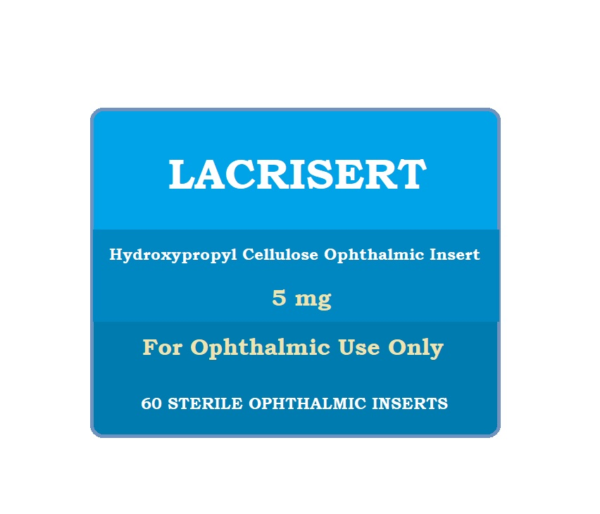Hydroxypropyl cellulose (HPC) is a derivative of cellulose, which is a natural polymer found in the cell walls of plants. HPC is modified by introducing hydroxypropyl groups onto the cellulose backbone. This modification enhances its solubility in water and some organic solvents, making it useful for various applications.
Lacrisert (Hydroxypropyl Cellulose) lubricates the eyes and increases the tear breakdown time. It is used in the treatment of patients with dry eye syndrome.
Hydroxypropyl cellulose Uses:
- Moderate to severe dry eye syndromes:
- It is used for the treatment of moderate to severe dry eye syndromes, including:
- keratoconjunctivitis sicca (especially in patients with severe disease who remain symptomatic despite an adequate trial of artificial tear solutions);
- Exposure keratitis;
- Decreased corneal sensitivity, and
- Recurrent corneal erosions
- It is used for the treatment of moderate to severe dry eye syndromes, including:
Hydroxypropyl Cellulose (Lacrisert) Dose in Adults
Hydroxypropyl Cellulose (Lacrisert) Dose in the treatment of moderate to severe dry eye syndromes:
- Use it in your eyes once a day.
- Put it in the lower part of your eye, under the base of the eyelid.
- Some people might need to use it twice a day.
This helps with the discomfort caused by dry eyes.
Use in Children:
Refer to adult dosing.
Pregnancy Risk Category: N
- Hydroxypropyl cellulose is a substance that doesn't interact much with the body and doesn't go through the process of metabolism.
- In studies with animals, it wasn't absorbed into the body when taken by mouth.
- For it to reach a developing baby in the womb (fetus), it would need to be absorbed into the bloodstream and then cross the placenta.
- However, based on available information, it seems that hydroxypropyl cellulose doesn't undergo significant absorption in the body, which suggests it's less likely to reach the fetus during pregnancy.
Dose in Kidney disease:
- The manufacturer's labeling does not include any changes to the dosage of hydroxypropyl cellulose.
- This is because it is not expected to be absorbed significantly into the bloodstream, meaning the body does not take in a large amount of the substance.
- Because of this low systemic absorption, there's typically no need to adjust the dosage.
Dose in Liver disease:
- The manufacturer's labeling for hydroxypropyl cellulose does not include any recommended changes to the dosage.
- The reason cited is the low likelihood of significant absorption into the systemic circulation.
- This suggests that the standard dosage specified in the labeling is expected to be appropriate for the intended use, and adjustments are not deemed necessary.
Side effects of Hydroxypropyl Cellulose (Lacrisert):
- Ophthalmic:
- Blurred vision
- Eye irritation
- Eyelid edema
Contraindications to Hydroxypropyl Cellulose (Lacrisert):
- If you're allergic or very sensitive to hydroxypropyl cellulose or any of the ingredients in the product, it's not a good idea to use it.
- Hypersensitivity means your body reacts strongly to something, and in this case, it could cause an allergic reaction.
Warnings and precautions
Corneal abrasion:
- Putting hydroxypropyl cellulose in the eye incorrectly can lead to a corneal abrasion.
- A corneal abrasion is like a scratch on the clear front surface of the eye, and it can be painful and cause discomfort.
- To avoid this, it's crucial to follow the proper instructions for using hydroxypropyl cellulose in the eye.
Ophthalmic effects
- Using hydroxypropyl cellulose in the eyes might cause a temporary blurring of vision.
- This means your vision might not be clear for a little while after using the product.
- It's important to be cautious when doing activities that require clear vision, such as driving or operating machinery.
- If you experience this blurring, taking out the insert for a few hours can help make your vision clearer again.
Monitoring Parameters:
None mentioned. Monitor for a response to the treatment.
How to administer Hydroxypropyl Cellulose (Lacrisert)?
- To use the hydroxypropyl cellulose product for your eyes, place it in the lower part of your eye, specifically in the space called the "inferior cul-de-sac."
- This area is beneath the base of the tarsus, which is not directly on the cornea or under the eyelid at the level of the tarsal plate.
- It's important to follow these specific instructions to ensure proper placement and effectiveness of the product.
Mechanism of action of Hydroxypropyl Cellulose (Lacrisert):
- Hydroxypropyl cellulose works in a way that helps stabilize and thicken the tear film in front of the eye.
- This tear film is important for maintaining the health of the eye's surface.
- In people with dry eyes, the tear film tends to break up quickly, leading to discomfort.
- Hydroxypropyl cellulose helps slow down this breakup of the tear film, providing relief for those with dry eye conditions.
- Additionally, it acts as a lubricant, making the eyes more comfortable, and offers protection to the eye's surface.
- Overall, it contributes to improving the condition of the eyes for individuals with dry eye issues.
Duration of Action:
- The effects of hydroxypropyl cellulose can last for up to 24 hours.
Absorption:
- The substance is not absorbed into the body.
Excretion:
- It is eliminated from the body through the feces.
International Brand Names of Hydroxypropyl cellulose:
- Lacrisert
Hydroxypropyl cellulose Brand Names in Pakistan:
Not available.







